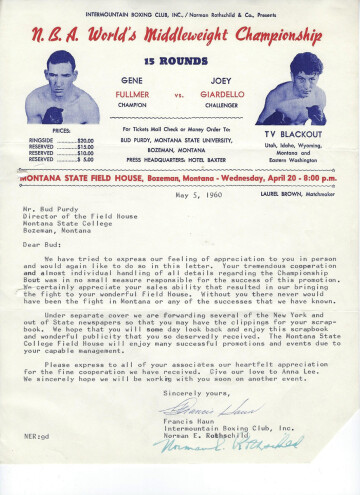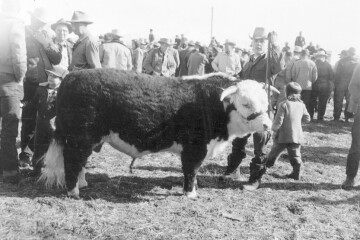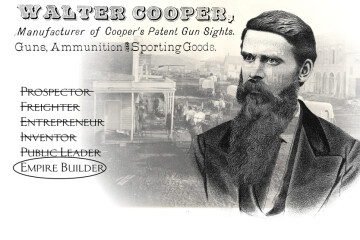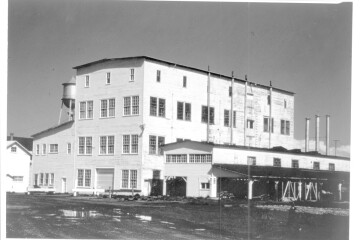Small Town Big Event
Bozeman’s Boxing Brawl 1960 National Boxing Association Middleweight Championship

On April 20, 1960, Bozeman Montana made national news when a young MSU Fieldhouse hosted what would later make headlines around the world when the National Boxing Association Middleweight Championship title match between Champion Gene Fullmer and Challenger Joey Giardello battled for 15 rounds in front of 12,122 fans. The crowd that saw Fullmer and Giardello was larger than Bozeman’s population of 11,325.
The story of why the championship title battle was being fought in Bozeman, Montana, was shared in the September 1960 boxing magazine, The Ring. “We were told that Bud Purdy, manager of the Montana State College fieldhouse, invested $1.25 in a telegram. The wire went to the manager of Fullmer, who turned it over to the president of the Intermountain Boxing Club. Soon officials were in Bozeman inspecting the plant. They needed only 10 minutes to close the deal with Purdy.”
Prior to this, match only one other national title had been fought in the state of Montana, the infamous Dempsey and Gibbons debacle, in Shelby, Montana, on the 4th of July 1923, that left four banks in Shelby bankrupt and the town’s dreams of prosperity disappearing almost as fast as the fighters and their managers.
While conversations were heard everywhere comparing the big match to that of Dempsey-Gibbons, any rumors of financial troubles were laid quickly aside. ABC bought the rights for the fight for $100,000 all of which was promised to Fullmer, and the gross gate paid by attendees was reportedly $111,088 of which $25,000 was to be Giardello’s purse. The Fieldhouse was rented for $3100.00 with Montana State College students acting as ushers and outside a sheriff’s posse, mounted on horseback, directed parking cars.
On the eve of the big fight, the Bozeman Daily Chronicle headline was “Fight Fans Pouring in for the Wednesday Bout” and stated that both camps were ready for the middleweight title scrap. While most fans drove, coming from all parts of Montana and surrounding states including Canada, many flew into town. All hotels and motels had been booked for weeks ahead and Livingston was seeing its share of fighting tourists as well. The Baxter Hotel was the official fight headquarters and many downtown businesses displayed fight posters and other memorabilia in their windows.
Standing 5’8” and weighing in at 159 ½ pounds, Champion Gene Fullmer’s nickname was the “Utah Cyclone,” and he hailed from West Jordan, Utah. Fullmer was a mink farmer and a member of The Church of Jesus Christ of Latter-day Saints, both of which were mentioned in press releases during his boxing career. Fullmer won the world middleweight championship on January 2, 1957, in Madison Square Garden when he upset the legendary Sugar Ray Robinson by soundly winning a unanimous 15-round decision. He lost the title five months later back to Sugar Ray and again won the title back in 1959 in what The Ring magazine called the “fight of the year” when he beat then titleholder, Carmen Basilo, with a 14th round TKO.
The author of The Ring magazine article describing Bozeman wrote, “It is filled with friendly people, who read a bright daily newspaper –the Bozeman Daily Chronicle—and look at television. There are the usual civic clubs and fraternal organizations. Fullmer trained at the Eagles Hall, while living on the college campus, the field house where the fight took place is a modern structure...the campus is spacious and attractive.”
Challenger Joey Giardello’s real name was Carmine Orlando Tilelli. Born in Brooklyn, New York, he lived most of his life in South Philadelphia, where, as a young man, he joined many other Italian-Americans in the city by taking up boxing. He turned professional in 1948, not long after his 18th birthday. It was said that Giardello changed his name to join the US Army under the legal age by using his cousin’s name. He served, underage, in an Airborne unit for the short remainder of World War II.
Ranked number 7, the contender would travel out west for pre-fight training in Livingston, where he was photographed with his wife, Rosalie, wearing a cowboy hat and posing for the newspapers with smiles all around. The smiles would be all gone by the opening bell Wednesday night April 20th and not return until long after his departure from the state.
Sports and fighting writer, Robert Polis, best describes the event in an article for thefightcity.com, “Fullmer vs Giardello wasn’t in Utah, but Montana might as well have been “The Beehive State” for all the support Giardello was likely to get two thousand miles away from his home turf of Flatbush in Brooklyn. But by the end of 15 brutal rounds, the sell-out crowd was cheering both men, Joey winning over more than a few with his courage and willingness to battle at close quarters with the iron-tough Fullmer. It was a savage brawl, highlighted by Fullmer’s impersonation of a billy goat as he repeatedly charged his challenger skull-first. In addition to head butts, Gene was also generous in doling out the elbows and rabbit punches. In round four an incensed Giardello, who was already cut over the right eye and had complained more than once to referee Harry Kessler regarding the foul tactics, lowered his head and blatantly cracked Fullmer one beauty of a head-smash. When Kessler intervened to admonish the challenger, Joey actually pushed him in frustration while waving at Fullmer as if to say, “If that’s how you want to fight, fine by me!”
Polis further wrote, “Kessler struggled to maintain control and for the remaining rounds it was a brutally violent scrap, Fullmer constantly attacking and throwing heavy shots to the body while Giardello countered with sharp hooks and uppercuts, his courage and refusal to cave in winning over the crowd. Some thought Joey was doing the sharper, cleaner work while others preferred Fullmer’s constant aggression. It was not an easy match to score and ringside cards were all over the place. The only thing people could agree on was that it was close. UPI gave it to the champion by two points, while the Associated Press saw it a draw. One judge tabbed Giardello the winner, another scored it for Fullmer, and the third saw it even; with the split draw Fullmer kept his title.”
The following day every newspaper in Montana lead with fight night stories, complete with graphic photographs as both men had gaping cuts over their eyes. One newspaper reported that “referee Harry Kessler was covered in the boxers’ blood and looked like he was wearing a butcher’s apron.” The Billings Gazette headline read “Fullmer, Giardello--Fight Mauling Draw” and the Great Falls Tribune headline was “Crowd Roars as Confusion Delays Official Decision.” National magazine Sports Illustrated wrote of the night in an article entitled, “A Mad Night in Montana,” and opens with “Middleweight champion Gene Fullmer retained his title but not all of his reputation in one of the rowdiest brawls in boxing history.” The article went on to compare the “crimson history of Montana bloody massacres” with the boxers “drawing freshets of blood in every round...they butted, heeled, punched low and snarled.”
In a smaller article, the Bozeman Daily Chronicle reported that the Sheriff and police officials said there were no unusual incident reports following the world championship fight with only one traffic accident involving three cars, one of which had faulty brakes. The portable canvas and ring were loaded up to be returned to Utah and the fieldhouse hosted the college rodeo the next day.
The crowds left, the local merchants were happy, and Bozeman and the surrounding area applauded Montana State College and the successful efforts of Brick Breeden Fieldhouse manager Bud Purdy. In many letters of thanks and congratulations, Mr. Purdy received letters from the Montana Governor, J. Hugo Aronson, the Sheriff, the Bozeman Chamber of Commerce, newspapers, and the Intermountain Boxing Club to name a few. In a letter dated June 30, 1960, the Chairman of the Fieldhouse Board, Max Worthington wrote Bud a letter for his third anniversary of managing the fieldhouse. “Dear Bud...the effectiveness of your advance publicity was beyond dispute with 80% of the $112,000 gate banked two weeks before the fight. Handling a crowd of over 12,000 people is no ordinary feat but the organization you perfected to assist the public from the parking lots to their seats made it appear simple.... Considering the unfavorable press that the professional fight game has had the past couple of years you are to be congratulated on giving this promotion the air of respectability that the public expected from a College campus.”
Fullmer and Giardello would not have a rematch. Fullmer was quoted as saying, “Anybody who does a thing like that in a championship fight shouldn’t get a rematch.” Gene Fullmer would hold his middleweight title until losing to Dick Tiger in the fall of 1962 with two rematches in 1963 that ended in first a draw and then a loss. Upon his retirement, he returned to his mink farm in Utah, he had a cameo role in the 1968 film, The Deadly Brigade as a Montana bartender, and he is featured on the cover of the album Greatest Hits by Alice in Chains. His last fight with Dick Tiger appears prominently in the music video for the Iggy Pop song, “American Valhalla.”
Joey Giardello would go on to beat Sugar Ray Robinson in June of 1963, for the world middleweight title and quickly defend it against Dick Tiger and Rubin Carter. He held the title for two years. When he retired from boxing, he returned to his given name and went into the insurance business and participated in fundraising events to benefit disabled children.
The bitterness though remained regarding the Montana bout. In 2005, Giardello was interviewed and stated that he felt very bad about it...” “I knew I won the fight. I beat him [but] they gave him a draw. I believe I won at least nine rounds. He kept coming in with his head, elbows and shoulders. I complained to the referee to step in but he didn’t. After Fullmer butted me many times I lost my cool and butted him back. I stood up to the bully. It wasn’t a pretty fight but I believe I won at least nine rounds.”




